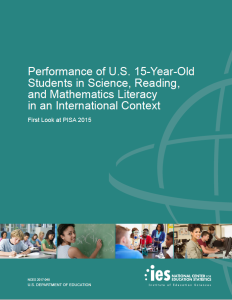Peter Lobner
In early December 2016, the U.S. Department of Education and the Institute for Educational Sciences’ (IES) National Center for Educational Statistics (NCES) issued a report entitled, “Performance of U.S. 15-Year-Old Students in Science, Reading, and Mathematics Literacy in an International Context: First Look at PISA 2015.”
The NCES describes PISA as follows:
“The Program for International Student Assessment (PISA) is a system of international assessments that allows countries to compare outcomes of learning as students near the end of compulsory schooling. PISA core assessments measure the performance of 15-year old students in science, reading and mathematics literacy every 3 years. Coordinated by the Organization for Economic Cooperation and Development (OECD), PISA was first implemented in 2000 in 32 countries. It has since grown to 73 educational systems in 2015. The United States has participated in every cycle of PISA since its inception in 2000. In 2015, Massachusetts, North Carolina and Puerto Rico also participated separately from the nation. Of these three, Massachusetts previously participated in PISA 2012.”
In each country, the schools participating in PISA are randomly selected, with a goal that the sample of student selected for the examination are representative of a broad range of backgrounds and abilities. About 540,000 students participated in PISA 2015, including about 5,700 students from U.S. public and private schools. All participants were rated on a 1,000 point scale.
The authors describe the contents of the PISA 2015 report as follows:
“ The report includes average scores in the three subject areas; score gaps across the three subject areas between the top (90th percentile) and low performing (10th percentile) students; the percentages of students reaching selected PISA proficiency levels; and trends in U.S. performance in the three subjects over time.”
You can download the report from the NCES website at the following link:
https://nces.ed.gov/pubsearch/pubsinfo.asp?pubid=2017048
In the three subject areas assessed by PISA 2015, key U.S. results include the following:
- Math:
- U.S. students ranked 40th (out of 73) in math
- U.S. average score was 470, which is below the international average of 490
- 29% of U.S. students did not meet the baseline proficiency for math
- 6% of U.S. students scored in the highest proficiency range for math
- U.S. average math scores have been declining over the last two PISA cycles since 2009
- Science:
- U.S. ranked 25th in science
- U.S. average was 496, which is very close to the international average of 493
- 20% of U.S. students did not meet the baseline proficiency for science
- 9% of U.S. students scored in the highest proficiency range for science
- U.S. average science scores have been flat over the last two PISA cycles since 2009
- Reading:
- U.S. ranked 24th in reading
- U.S. average was 497, which is very close to the international average of 493
- 19% of U.S. students did not meet the baseline proficiency for reading
- 10% of U.S. students scored in the highest proficiency range for reading
- U.S. average reading scores have been flat over the last two PISA cycles since 2009
In comparison, students in the small nation of Singapore were the top performers in all three subject areas, recording the following results in PISA 2015:
- Math: 564
- Science: 556
- Reading: 535
Japan, South Korea, Canada, Germany, New Zealand, Australia, Hong Kong (China), Estonia, and Netherlands were among the countries that consistently beat the U.S. in all three subject areas.
China significantly beat the U.S. in math and science and was about the same in reading. Russia significantly beat the U.S. in math, but was a bit behind in science and reading.
Numerous articles have been written on the declining math performance and only average science and reading performance of the U.S. students that participated in PISA 2015. Representative articles include:
US News: 6 December 2016 article, “Internationally, U.S. Students are Failing”
Washington Post: 6 December 2016, “On the World Stage, U.S. Students Fall Behind”
I think the authors of these articles are correct and the U.S. educational system is failing to develop students in high school that, on average, will be able to compete effectively in a knowledge-based world economy with many of their international peers.
Click the link to the PISA 2015 report (above) and read about the international test results for yourself.
